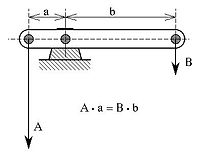![[4.GIF]](https://blogger.googleusercontent.com/img/b/R29vZ2xl/AVvXsEirMZ4wv6jNwzByxPignWI-TfRzV6x8qR5yN-kDQBrkTawJTqAMGMamli5pKfGs1mM3ry6L33aysMwFpiZ1-Qc1A56tUWfJDLGbqT55C_wOotXqNFEu304c8WHUiDrrAByHrgSQ9uS7pGlk/s1600/4.GIF)
Mechanical advantage
In physics and engineering, mechanical advantage (MA) is the factor by which a mechanism multiplies the force put into it. Following are simple machines where the mechanical advantage is calculated.

- The beam shown is in static equilibrium around the fulcrum. This is due to the moment created by vector force "A" counterclockwise (moment A*a) being in equilibrium with the moment created by vector force "B" clockwise (moment B*b). The relatively low vector force "B" is translated in a relatively high vector force "A". The force is thus increased in the ratio of the forces A : B, which is equal to the ratio of the distances to the fulcrum b : a. This ratio is called the mechanical advantage. This idealised situation does not take into account friction. For more explanation, see also lever.
- Wheel and axle: A wheel is essentially a lever with one arm the distance between the axle and the outer point of the wheel, and the other the radius of the axle. Typically this is a fairly large difference, leading to a proportionately large mechanical advantage. This allows even simple wheels with wooden axles running in wooden blocks to still turn freely, because their friction is overwhelmed by the rotational force of the wheel multiplied by the mechanical advantage.
- Pulley: Pulleys change the direction of a tension force on a flexible material, e.g. a rope or cable. In addition, pulleys can be "added together" to create mechanical advantage, by having the flexible material looped over several pulleys in turn. More loops and pulleys increases the mechanical advantage.
Subscribe to:
Post Comments (Atom)
0 comments:
Post a Comment